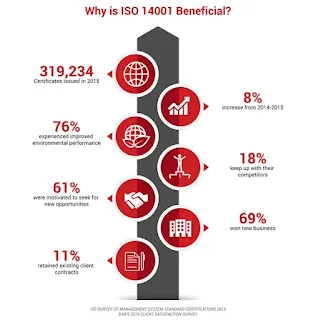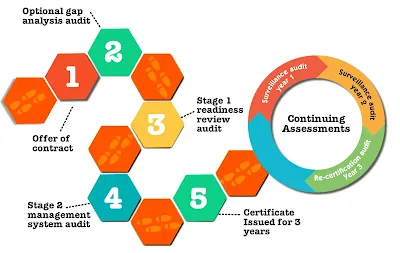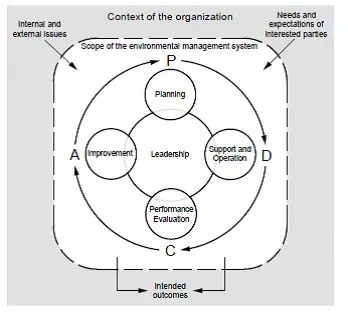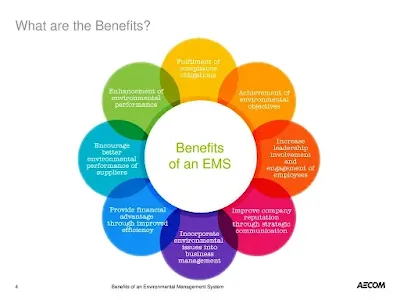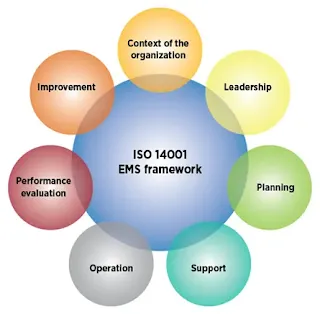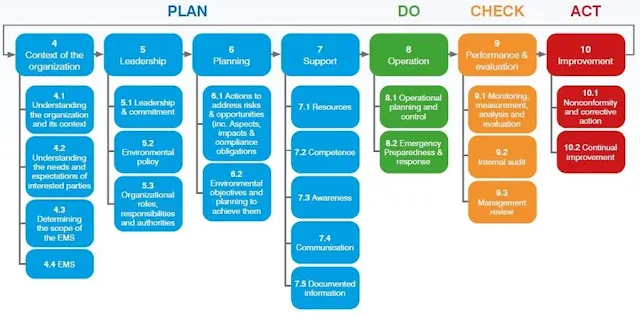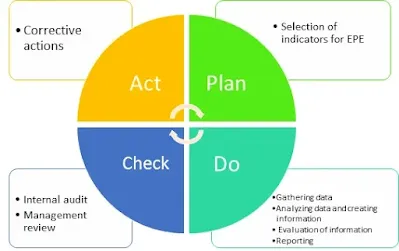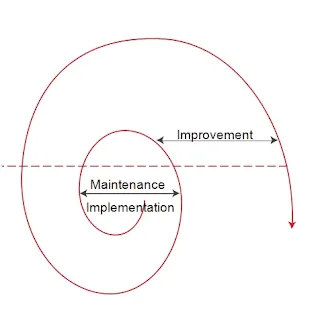ISO 14001 the environmental management system standard
What are the main objectives of ISO 14001?
The main objectives of ISO 14001 include:
Identifying and managing the environmental aspects of an organization's activities, products, or services.
Implementing the management system to control and improve the organization's environmental accomplishment.
Continuously improving the organization's environmental execution.
Complying with relevant environmental laws and regulations
Getting to the heart of why is ISO 14001 important?
ISO 14001 is important for a number of reasons. Firstly, ISO 14001 helps organizations to identify and manage their environmental impacts, which can lead to cost savings and improved efficiency. Additionally, the standard ISO 14001 can help organizations to comply with the environmental policy and regulations, which can help to protect the environment and avoid costly fines.
Furthermore, implementing an environmental management system standards ISO 14001 can help organizations to improve their reputation and credibility with customers, suppliers, and other stakeholders. This can help organizations to attract and retain customers and to build relationships with suppliers and other partners.
In addition, ISO 14001 can also help organizations to improve their relationships with the community and to contribute to sustainable development. ISO 14001 can help organizations to build a positive reputation and to become more resilient in the face of environmental challenges
What are the key changes in the revised standard of an environmental management system?
ISO 14001:2015 is the new standard of environmental management system (EMS) ISO 14001. The revised management system standard of ISO 14001 provides a framework for your organizations to identify and manage your company's environmental impacts, and improve overall environmental achievements. The new standard of ISO 14001 brings a number of significant changes that organizations need to be aware of in order to maintain their certification.
One of the key changes in the new standard of ISO 14001 is the increased focus on leadership and commitment. The new standard ISO 14001 requires organizations to demonstrate that top management is actively engaged in the development and implementation of the EMS, and that they have a clear understanding of the organization's environmental impacts and their legal and other requirements.
Another important change in ISO 14001 is the inclusion of a new clause on risk-based thinking. This means that organizations must now consider the potential environmental risks and impacts of their activities, products, or services, and take steps to mitigate or prevent them. This includes identifying and assessing the risks, implementing control measures, and monitoring and reviewing the effectiveness of those measures.
A third change in ISO 14001 is the increased emphasis on communication and engagement with stakeholders. Organizations must now demonstrate that they have a process in place for communicating with internal and external stakeholders about their environmental implementation, and that they are taking into account the concerns and expectations of those stakeholders.
What are the practical steps to becoming ISO 14001 certified?
The first step is to conduct a gap analysis to determine where your organization currently stands in relation to the standard. This will help you to identify any areas where changes need to be made in order to meet the standard's requirements.
Next, you'll need to develop an environmental policy and objectives that are consistent with the standard. This should be a statement of your organization's commitment to environmental protection, and should set out the specific goals and targets that you plan to achieve.
After that, you'll need to implement an environmental management system that meets the requirements of the standard. This should include procedures for identifying and managing environmental impacts, monitoring and measuring performance, and reviewing and continuously improving the EMS.
Finally, you'll need to undergo an external assessment by a certified auditor to verify that your organization's EMS meets the requirements of the standard ISO 14001. Once you have passed the assessment, you'll be awarded an ISO 14001 certificate, which is valid for three years.
Plan-Do-Check Act Model for EMS ISO 14001
Plan–establish objectives and processes required
Do–implement the processes
Check–measure and monitor the processes and report results
The third step is to measure and monitor the processes and report the results. This includes measuring and monitoring the environmental aspects, impacts, and performance indicators, and reporting the results to relevant stakeholders. This step is important for organizations to identify areas for improvement and to demonstrate their environmental achievements to stakeholders.
Act–take action to improve the performance of ISO 14001 EMS based on results
The final step is to take action to improve the performance of the EMS based on the results. This includes identifying and implementing corrective and preventive actions, and continuously monitoring and improving the environmental management system.
An Environmental Management System -the business benefits
Implementing an environmental management system based on ISO 14001 can bring many benefits to an organization. These benefits include:
Compliance with legal and regulatory requirements: ISO 14001 standard helps organizations to identify and comply with all relevant environmental laws and regulations, reducing the risk of fines and penalties.
Cost savings: ISO 14001 standard can help organizations to identify and reduce waste, improve resource efficiency, and reduce energy consumption, resulting in cost savings.
Improved environmental accomplishment: ISO 14001 standard helps organizations to identify and reduce their environmental impacts, improve their environmental accomplishment, and demonstrate their commitment to sustainability.
Increased competitiveness: Organizations that have ISO 14001 standard in place can use it as a competitive advantage, as it demonstrates to customers, suppliers, and other stakeholders that the organization is committed to environmental responsibility.
Improved stakeholder relations: ISO 14001 Standards helps organizations to communicate and engage with stakeholders, such as customers, suppliers, and local communities, on environmental issues.
Better risk management: ISO 14001 Standards help organizations to identify and manage environmental risks, reducing the risk of environmental incidents and improving their overall risk management strategies.
Improved employee engagement: ISO 14001 Standards help to raise awareness and improve employee engagement on environmental issues, which can lead to improved productivity and employee morale.
Overall, implementing an EMS based on ISO 14001 can bring many business benefits to organizations, including compliance with legal and regulatory requirements, cost savings, improved environmental accomplishment, increased competitiveness, improved stakeholder relations, better risk management, and improved employee engagement.
Requirements of ISO 14001- Clause by Clause explained
1 Scope
The scope of ISO 14001 provides a framework for organizations to improve their environmental targets, reduce their environmental impacts, and demonstrate their commitment to sustainability. It is applicable to any organization and can be integrated with other management system standards to help organizations to manage their environmental accomplishment in a holistic and integrated way.
The ISO 14001 standard is also designed to be used in conjunction with other management system standards, such as ISO 9001 (quality management) and ISO 45001 (occupational health and safety), to help organizations to integrate their environmental management with their overall management systems.
The scope of ISO 14001 includes the environmental aspects of an organization's operations, products, and services, and the environmental impacts that they have on the environment. It also includes the processes and procedures that an organization uses to manage its environmental accomplishment, including environmental management, environmental planning, environmental review, and environmental performance evaluation.
2 Normative references
ISO 14001 includes several normative references that organizations should be aware of when implementing an environmental management system. These normative references are important because they provide additional information and guidance that organizations can use to implement their EMS.
The normative references in ISO 14001 include:
ISO 9000:2015 - Quality management systems - Fundamentals and vocabulary
ISO 14004:2016 - Environmental management systems - General guidelines on implementation
ISO 19011:2018 - Guidelines for auditing management systems
ISO/IEC 17021-1:2015 - Conformity assessment - Requirements for bodies providing audit and certification of management systems
ISO 9000:2015 provides the fundamentals and vocabulary of quality management systems, which can be used to understand the concepts and terminology used in ISO 14001.
ISO 14004:2016 provides general guidelines on the implementation of an EMS and can be used as a supplementary resource for organizations that are implementing an EMS for the first time.
ISO 19011:2018 provides guidelines for auditing management systems, including an EMS. It can be used by organizations to conduct internal or external audits of their EMS.
ISO/IEC 17021-1:2015 provides requirements for bodies providing audit and certification of management systems, including an EMS. It can be used by organizations that are seeking certification of their EMS from a third-party certification body.
In summary, the normative references in ISO 14001 provide additional information and guidance that organizations can use to implement their environmental management systems effectively and efficiently. Organizations should be familiar with these normative references and use them as a supplementary resource when implementing their EMS.
3 Terms and definitions
3.1 Terms related to organization and leadership
Management system
The management system is a set of policies, processes, and procedures that an organization uses to manage its operations and achieve its objectives.
It is designed to help organizations to improve their performance and achieve their goals.
context of the organization
The context of the organization refers to the internal and external factors that can impact the organization's ability to meet the requirements of the standard and achieve its health and safety objectives.
This includes factors such as the organization's size, structure, culture, and operating environment, as well as external factors such as legal and regulatory requirements, industry standards, and stakeholder expectations.
The context of the organization is required to be considered when developing and implementing its Occupational Health and Safety (OH&S) management system, and to regularly review and update it as necessary.
Environmental Management System
An Environmental Management System is the management system standards that is designed to help organizations to improve their environmental performance, reduce their environmental impacts, and demonstrate their commitment to sustainability. It is based on the ISO 14001 standard.
Environmental policy
An environmental policy is a statement that sets out an organization's commitment to environmental responsibility and sustainability. It provides a framework for the organization to manage its environmental accomplishment and impacts.
Organization
An organization is a group of people who work together to achieve a common goal or purpose. It can be a business, government agency, non-profit, or other type of entity.
Top management
Top management refers to the highest level of management within an organization. It includes the board of directors, executive management team, or other senior leaders who are responsible for making strategic decisions and providing leadership for the organization.
Interested party
An interested party is an individual or group that has an interest in or is affected by the activities, products, or services of an organization. This can include customers, suppliers, employees, shareholders, regulators, and members of the local community. Organizations should engage with interested parties to understand their expectations and needs and to manage the environmental impacts of their operations.
3.2 Terms related to planning
3.2.1 Environment
The environment refers to the natural and physical surroundings in which an organization operates. This includes air, water, land, and natural resources, as well as the living organisms that inhabit them.
3.2.2 Environmental aspect
An environmental aspect is an element of an organization's activities, products, or services that can interact with the environment. It can have a positive or negative impact on the environment. Examples of environmental aspects include energy consumption, waste generation, and emissions to air and water.
3.2.3 Environmental condition
An environmental condition refers to the state or quality of the environment in a specific location or area. This can include factors such as air and water quality, soil quality, and biodiversity.
3.2.4 Environmental impact
An environmental impact is any change to the environment that results from an organization's activities, products, or services. This can include positive impacts, such as the conservation of natural resources, or negative impacts, such as pollution or the destruction of habitats.
3.2.5 Objective
An objective is a specific target or goal that an organization sets to achieve. It is a statement of what the organization wants to achieve and is used to measure progress and performance.
3.2.6 environmental objective
An environmental objective is a specific target or goal that an organization sets to achieve in relation to its environmental performance. It is a statement of what the organization wants to achieve in terms of reducing its environmental impacts and improving its environmental goals. Examples of environmental objectives include reducing energy consumption, reducing waste generation, and reducing emissions to air and water.
3.2.7 prevention of pollution
Prevention of pollution refers to actions that an organization takes to prevent or minimize the release of harmful substances or energy into the environment. This can include measures such as reducing the use of hazardous materials, implementing best practices for waste management, and monitoring and controlling emissions.
3.2.8 requirement
A requirement is a specific demand or expectation that an organization must meet. It can be a legal requirement, an industry standard, or an internal requirement established by the organization.
3.2.9 compliance obligations (preferred term)
Compliance obligations refer to the legal and other requirements that an organization must meet in order to comply with environmental regulations and standards.
legal requirements and other requirements (admitted term)
Legal requirements are the laws and regulations that an organization must comply with in order to operate legally. They can include national, state, and local laws and regulations related to environmental protection.
3.2.10 risk
Risk refers to the likelihood and potential impact of an event or situation that could negatively affect an organization's operations or reputation.
3.2.11 risks and opportunities
Risks and opportunities refer to the positive and negative effects that an organization's activities, products, or services may have on the environment. Identifying and assessing risks and opportunities helps organizations to identify potential areas for improvement and to take advantage of opportunities to improve their environmental performance.
3.3 Terms related to support and operation
3.3.1 competence
Competence refers to the knowledge, skills, experience, and qualifications that an individual or organization has to perform a specific task or activity. It is important for organizations to ensure that their employees have the necessary competence to perform their roles and responsibilities related to the environmental management system.
3.3.2 documented information
Documented information refers to any written or electronic information that an organization uses to support its environmental management system. This can include policies, procedures, records, and plans.
3.3.3 life cycle
Life cycle refers to the stages that a product or service goes through from its development, to its use, and to its disposal or recycling. Organizations should consider the life cycle of their products and services when assessing their environmental impacts and implementing their environmental management system.
3.3.4 outsource (verb)
Outsource refers to the process of obtaining goods or services from an external supplier. Organizations may outsource certain aspects of their operations, such as waste management or energy management, to specialized providers.
3.3.5 process
A process is a series of actions or steps that an organization takes to achieve a specific goal or objective. It can be a specific activity related to the environmental management system, such as a procedure for monitoring emissions, or a broader process such as the overall environmental management process.
3.4 Terms related to performance evaluation and improvement
3.4.1 audit
An audit is a systematic and independent examination of an organization's environmental management system to determine whether it conforms to the requirements of ISO 14001 and whether it is effectively implemented and maintained.
3.4.2 conformity
Conformity refers to the degree to which an organization's environmental management system meets the requirements of ISO 14001.
3.4.3 nonconformity
Nonconformity refers to a deviation from the requirements of ISO 14001. It can be identified during an audit or through other means of monitoring and measurement.
3.4.4 corrective action
Corrective action refers to the steps that an organization takes to eliminate the cause of a nonconformity and to prevent it from recurring.
3.4.5 continual improvement
Continual improvement refers to the ongoing process of evaluating and improving an organization's environmental management system to achieve better environmental performance.
3.4.6 effectiveness
Effectiveness refers to the degree to which an organization's environmental management system is achieving its intended results and objectives.
3.4.7 indicator
An indicator is a measurable characteristic that is used to evaluate an organization's environmental performance. Examples of environmental performance indicators include energy consumption, emissions to air and water, and waste generation.
3.4.8 monitoring
Monitoring refers to the regular observation and measurement of an organization's environmental performance and impacts.
3.4.9 measurement
Measurement refers to the process of determining the value or quantity of an environmental aspect or impact.
3.4.10 performance
Performance refers to the degree to which an organization is achieving its goals and objectives.
3.4.11 environmental performance
Environmental performance refers to the degree to which an organization is achieving its environmental goals and objectives, and reducing its environmental impacts.
4. Context of the Organization
4.1 Understanding the organization and its context
4.2 Understanding the needs and expectations of interested parties
4.3 Determining the scope of Environmental management systems
4.4 Environmental Management System
5 Leadership
5.1 leadership and commitment
5.2 Environmental Policy
5.3 Organizational roles, responsibilities and authorities
6. Planning
6.1 Actions to address risks and opportunities
6.1.1 General
The first step in identifying and addressing risks and opportunities is to conduct a general assessment of the organization's environmental aspects and impacts. This includes identifying the environmental aspects of the organization's operations, products, and services, as well as the environmental impacts that they have on the environment.
6.1.2 Significant Environmental Aspects
Once the general assessment is complete, organizations should focus on identifying and addressing the significant environmental aspects of their operations, products, and services. These are the environmental aspects that have the greatest impact on the environment and are therefore most critical to the organization's environmental performance.
6.1.3 Compliance Obligations
Another important aspect of the planning process is identifying and addressing compliance obligations. Organizations must comply with a variety of national, state, and local laws and regulations related to environmental protection. By identifying and addressing these compliance obligations, organizations can ensure that they are operating legally and in compliance with environmental regulations.
6.1.4 Planning to Take Action
Once the risks and opportunities have been identified and assessed, organizations should develop a plan to take action to address them. This includes setting environmental objectives and targets, and identifying the resources and support that are necessary to achieve them.
6.2 Environmental objectives and planning to achieve them
The final step in the planning process is to set environmental objectives and targets, and to develop a plan to achieve them. Environmental objectives are specific targets or goals that an organization sets to achieve in relation to its environmental performance. These objectives should be specific, measurable, achievable, relevant, and time-bound (SMART). By setting environmental objectives and developing a plan to achieve them, organizations can improve their environmental performance, reduce their environmental impacts, and demonstrate their commitment to sustainability.
ISO 14001 provides a framework for organizations to improve their environmental performance and achieve their environmental objectives. By following the planning process outlined in the standard, organizations can identify and address risks and opportunities, set environmental Management Systems requirements.
7 Support
7.1 Resources
7.2 Competence
7.3 Awareness
7.4 Communication
7.5 Documented Information
Mandatory documents- The standard requires organizations to maintain certain mandatory documents such as the environmental policy, objectives, and procedures.
Non-mandatory documents- Additionally, organizations are required to maintain non-mandatory documents such as records, reports, and plans as needed to demonstrate the effective operation of the system. Organizations should ensure that all documents are accurate, up-to-date, and easily accessible to employees and other stakeholders.
8. Operation
8.1 Operational planning and control
8.2 Emergency preparedness and response
One of the key concepts of environmental control is the prevention of pollution. This includes taking steps to reduce the use of natural resources, minimize the generation of waste and emissions, and prevent or minimize the release of pollutants into the environment. Organizations can achieve this by implementing best practices, using energy and resource-efficient technologies, and promoting sustainable practices.
Another important aspect of operational planning and control is emergency preparedness and response. This involves developing and implementing procedures to respond to emergency situations, such as spills, releases of pollutants, or natural disasters. This helps organizations to minimize the impact of such events on the environment and on the community, and to ensure a quick and effective response.
ISO 14001 provides a comprehensive framework for organizations to manage their environmental performance. The focus on operational planning and control, including concepts of environmental control and emergency preparedness and response, helps organizations to identify and address potential environmental risks and opportunities, and to ensure that their operations are in compliance with legal and other requirements. By implementing the principles of ISO 14001, organizations can improve their environmental performance and protect the environment for future generations.
9. Performance evaluation
One of the key components of this standard is performance evaluation, which is essential for ensuring the effectiveness of the environmental management system. In this section, we will discuss the three main clauses of the ISO 14001 standard related to performance evaluation:
9.1 Monitoring, measuring, analysis and evaluation
Monitoring, measuring, analysis and evaluation is all about monitoring and measuring the environmental performance of the organization. This includes monitoring and measuring the environmental aspects of the organization's activities, products, and services, as well as analyzing and evaluating the data collected. The organization must also establish and implement procedures for monitoring and measuring the environmental performance of the organization, as well as for analyzing and evaluating the data collected. This helps the organization to identify areas for improvement and to develop and implement action plans to improve the environmental performance of the organization.
9.2 Internal audit program
Internal audit program is all about performing internal audits of the environmental management system. The organization must establish, implement, and maintain an internal audit program to ensure the effectiveness of the environmental management system. The internal audit program must include the following:
The scope of the internal audit
The frequency of the internal audit
The criteria for selecting auditors
The responsibilities of the auditors
The procedures for conducting the internal audit
The follow-up actions to be taken after the internal audit
The internal audit program is an essential tool for identifying areas for improvement and for ensuring that the environmental management system is being implemented effectively.
9.3 Management review
Management review is all about reviewing the environmental management system to ensure that it is effective. The management review must include the following:
A review of the environmental performance of the organization
A review of the environmental aspects of the organization's activities, products, and services
A review of the environmental management system
A review of the internal audit program
A review of the results of the internal audit program
A review of the follow-up actions to be taken after the internal audit
The management review is an essential tool for ensuring that the environmental management system is being implemented effectively and that the organization is meeting its environmental objectives.
10 Improvement
10.1 General
10.2 Nonconformity and corrective action
10.3 Continual Improvement Process
Clause 10.3 lays out the guidelines for an effective continual improvement process. This includes setting environmental objectives and targets, monitoring and measuring the performance of the EMS, and taking corrective actions as needed. The organization must also review its environmental performance regularly and make any necessary changes to the EMS.
In conclusion, ISO 14001 places a strong emphasis on continual improvement. This includes identifying and addressing nonconformities, implementing corrective actions, and regularly reviewing the effectiveness of the EMS. By following these guidelines, organizations can ensure that their environmental management system is effective and that they are achieving their environmental objectives.
Integration with other management systems
In addition to the guidelines outlined in Clause 10, ISO 14001 also encourages organizations to integrate their environmental management system (EMS) with other management systems. This includes systems such as quality management, health and safety, and energy management. By integrating these systems, organizations can achieve greater efficiency and effectiveness in their overall management practices.
One of the key benefits of integrating an EMS with other management systems is that it can help to reduce duplication of effort and resources. For example, by incorporating environmental considerations into an organization's quality management system, they can ensure that their products and services are not only of high quality but also environmentally friendly.
Furthermore, integrating an EMS with other management systems can also help organizations to identify and address potential environmental risks more effectively. For example, by incorporating health and safety considerations into an organization's environmental management system, they can identify potential hazards and take appropriate action to mitigate them.
Lastly, integrating an EMS with other management systems can also help organizations to meet the requirements of multiple regulations and standards more efficiently. For example, by incorporating energy management into an organization's environmental management system, they can not only reduce their environmental impact but also comply with energy efficiency regulations.
Implementation of an EMS with IMS2 methodology
Implementing an environmental management system (EMS) with the Integrated Management System (IMS2) methodology can provide organizations with a holistic approach to managing their environmental, quality, and safety performance. The IMS2 methodology is based on the principle that an organization's management systems should be integrated and aligned to achieve better results.
The first step in implementing an EMS with IMS2 methodology is to conduct a gap analysis to determine where the organization currently stands in terms of environmental performance and where it needs to improve. This includes identifying any nonconformities and areas for improvement, as well as setting environmental objectives and targets.
The next step is to develop a plan for implementing the EMS. This includes identifying the resources needed, such as personnel, equipment, and training, as well as outlining the specific actions that need to be taken. The organization should also establish a process for monitoring and measuring its environmental performance, as well as for taking corrective actions as needed.
Once the plan is in place, the organization should begin implementing the EMS. This includes training employees on the new system, as well as communicating the changes to all stakeholders. The organization should also establish a system for monitoring and measuring its environmental performance, as well as for taking corrective actions as needed.
The final step is to review the effectiveness of the EMS and make any necessary improvements. This includes conducting regular audits and management reviews, as well as monitoring environmental performance of the organization.
In conclusion, implementing an EMS with the IMS2 methodology can provide organizations with a holistic approach to managing their environmental, quality, and safety performance. It is based on the principle that an organization's management systems should be integrated and aligned to achieve better results. By following the steps outlined above, organizations can ensure that their EMS is effective and that they are achieving their environmental goals.
Why should you implement ISO 14001 in your organization?
There are several reasons why an organization should consider implementing ISO 14001, the international standard for an environmental management system (EMS). Some of the key benefits include:
Compliance with regulations and standards: ISO 14001 can help organizations comply with a wide range of environmental regulations and standards. By implementing ISO 14001, organizations can identify and address potential environmental risks and liabilities, and ensure that they are meeting their legal and regulatory requirements.
Improved environmental performance: Implementing ISO 14001 can help organizations improve their environmental performance by identifying areas for improvement and setting environmental targets. This can lead to reduced environmental impact and improved sustainability.
Increased efficiency: An EMS can help organizations identify and eliminate inefficiencies in their operations, leading to cost savings and increased efficiency. For example, by reducing waste and energy consumption, organizations can lower your company's operating costs.
Improved reputation: Organizations that implement ISO 14001 and achieve certification to ISO 14001 can demonstrate their commitment to environmental protection and sustainability. This can enhance their reputation and attract customers, suppliers, and investors who are looking for environmentally responsible businesses.
Improved risk management: By identifying and addressing potential environmental risks, ISO 14001 Certified organizations can mitigate the potential for negative impacts on their operations, employees, and the community.
In conclusion, implementing ISO 14001 can provide organizations with many benefits, including compliance with regulations and international standard, improved environmental performance, increased efficiency, improved reputation, and improved risk management. ISO 14001 standard is a robust system that helps organizations to improve their environmental performance, manage their environmental risks and achieve their environmental scheme.
What is the latest version of ISO 14001?
Frequently Asked Questions (FAQs):
- What
is environment? Environment refers to the natural surroundings in
which living organisms, including humans, exist. It includes all the
living (biotic) and non-living (abiotic) elements that interact and
influence each other, creating a delicate balance for life to thrive on
Earth.
- What
are the components of the environment? The components of the
environment include air, water, soil, flora, fauna, minerals, climate, and
various ecological systems. These components are interconnected and
dependent on each other.
- Why
is sustainable development important in terms of the environment?
Sustainable development ensures that current needs are met without
compromising the ability of future generations to meet their needs. It is
vital for the environment as it promotes responsible resource management,
biodiversity conservation, and minimizes the negative impact of human
activities on the natural world.
- How
to protect the environment? To protect the environment, we can:
- Reduce,
reuse, and recycle to minimize waste generation.
- Promote
the use of renewable energy sources.
- Preserve
natural habitats and promote biodiversity conservation.
- Adopt
eco-friendly practices in industries and daily life.
- Raise
awareness and advocate for environmental protection.
- What
is environment and sustainable development? Environment and
sustainable development are interconnected concepts. Environment refers to
the natural surroundings, and sustainable development ensures that human
activities are carried out in a way that preserves the environment's
health and supports future generations.
- Why
is environment conservation important? Environment conservation is
crucial because it ensures the preservation of biodiversity, ecological
balance, and the availability of resources for future generations. It
helps maintain a healthy and habitable planet.
- How
can we make our environment clean? To make the environment clean, we
can:
- Properly
dispose of waste and promote recycling.
- Control
pollution from industries and vehicles.
- Plant
trees and participate in afforestation efforts.
- Conserve
water and reduce water pollution.
- Use
eco-friendly products and technologies.
- How
do greenhouse gases affect the environment? Greenhouse gases trap heat
in the Earth's atmosphere, leading to the greenhouse effect. This effect
causes global warming and climate change, resulting in extreme weather
events, rising sea levels, and disruption of ecosystems.
- What
does plastic do to our environment? Plastic pollution has severe
environmental impacts. It leads to the degradation of ecosystems, harms
wildlife through ingestion and entanglement, and contributes to marine
pollution.
- How
can we keep our environment clean? To keep the environment clean, we
can:
- Avoid
littering and practice responsible waste disposal.
- Reduce
plastic usage and opt for reusable alternatives.
- Support
eco-friendly initiatives and sustainable practices.
- Participate
in community cleanup programs.
- How
does population growth affect the environment? Rapid population growth
increases the demand for resources, putting pressure on ecosystems. It
leads to deforestation, habitat destruction, and increased carbon
emissions, exacerbating environmental issues.
- What
are the challenges of the environment? Environmental challenges
include climate change, pollution (air, water, and soil), loss of
biodiversity, deforestation, desertification, and depletion of natural
resources.
- What
is the Environment Management System? The Environment Management
System (EMS) is a structured approach used by organizations to manage and
reduce their environmental impacts effectively. It involves setting
environmental objectives, implementing action plans, and continuously
improving environmental performance.
- What
do you mean by the socio-cultural aspect of the environment? The
socio-cultural aspect of the environment refers to the interactions
between the environment and human societies, including cultural practices,
traditional knowledge, and the impact of human behavior on the
environment.
- How
can we conserve the environment? We can conserve the environment by:
- Promoting
sustainable practices in agriculture, industry, and urban planning.
- Protecting
natural habitats and promoting biodiversity conservation.
- Adopting
renewable energy sources and reducing greenhouse gas emissions.
- Encouraging
eco-friendly lifestyles and responsible consumption.
- When
was the Environment Conservation Act formulated in Nepal? The
Environment Conservation Act in Nepal was formulated on 14th June 1996.
- How
can we save the environment from pollution? To save the environment
from pollution, we must:
- Implement
strict pollution control regulations and standards.
- Promote
cleaner production methods in industries.
- Encourage
public transportation and fuel-efficient vehicles.
- Raise
awareness about the impacts of pollution and involve communities in
pollution control efforts.
- How
does sustainable development help the environment? Sustainable
development ensures that economic, social, and environmental goals are
balanced. It promotes responsible resource use, minimizes pollution, and
preserves ecosystems, leading to a healthier and more sustainable
environment.
It is important to work with a reputable ISO consultant like ISO Certification in Nepal Pvt. Ltd. that can provide cost effective expert guidance and support to your organization throughout the process of ISO 9001 implementation. We are the leading ISO System Certification body in Nepal. We will help an organization to understand requirements, implement the standard and ensure that your company is in compliance with any ISO Certification in Nepal. Besides to ISO 9001 quality management system, we also provide ISO 14001( Environmental management System certification) , ISO 22000(Food Safety Management System Certification) ISO 45001 Occupational health and safety management system , ISO 27001 Information Security Management System . ISO/IEC 17025 Testing and calibration laboratories Organic Certification in Nepal. If you have any queries as well as if you want to get your organization to be ISO Certified, please call 9840525565 to get free consultation on ISO Certification service and know which ISO standards is best for your organization.

